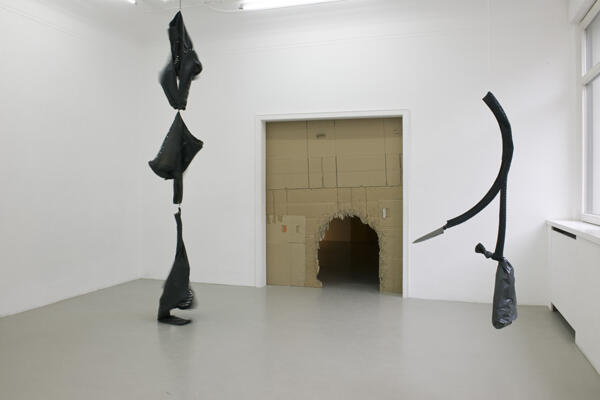Moris
Michael Sturm, Stuttgart
In a closed space, everyday situations become altered. The order in which we have built a figuration of the world then provides us a dramatic quality, a theatricality which manifests itself through increasingly reduced and repetitive statements.

Everything turns into resonance of the noises of the inhabitant, of his steps in the course of time and of the vital gesture that certain objects enhance. But that closed space may have the scale of Mexico City, of the Mexican territory today; it already belongs, in fact, to this scale of amorphous volumes and powefully monotonous sonorities, where the population withdraws into margins within which it dramatizes violent scenes of the same uncensored movie.
It is in this closed space that Moris´ assemblages emerge, more and more offensive and systematized. The use of revolving mechanisms in the piece La bestia tendrá su día, after which this exhibition is named, indicates the obsession of the thought focused on the other’s extermination, just like that knife suspended from a snake made of bicycle tires which spins incessantly until it touches the ground, generates a groove and tortures those who remain in the barely lit room.
The evidence of the body, more and more specific in the production, also bifurcates. On one end the corporeal element is the weapon which fits in a hand that brandishes it in defense of its belongings, in a sort of Meccano of assault ( Defensa personal); on the other, the body is a track marked on three leather jackets ( Leal al hombre equivocado), which become connected in a chain of command that goes from heaven to earth in a fall. The piece revolves slowly, contracts and expands like the metaphor of loyalty when the priority is to survive. What is really being stated is the possibility of being wittier than the strong, stronger than the rich, richer than anyone.
In the Mexican press releases there is always a heading that overflows each piece of news, which sells and multiplies the morbidity. The pages include not only the narration, but also the temperature of the massacred bodies found, the smell of the bags of fluids, the looks of victims and victimizers with the specific weight of cement, like in the Chacal pieces. It is a daily diary that Moris has learned to dissect and that he subjects to different processes of thought.
The images are catalogued for their alteration generating different pictorial series, of which in this exhibition we can see two: the one that closes crime down ( Paisajes censurado) and the one which allows crime or the landscape to re-signify itself on its own in a geometry of voids ( Cielo roto). In both pieces the background overcomes the figure, while the beast breathes.
-
 La bestia tendrá su dia, 2013.
La bestia tendrá su dia, 2013.
Exhibition view at Galerie Michael Sturm, Stuttgart, Germany/Vista de la exposición en la Galería Michael Sturm, Stuttgart, Alemania
Photo/Foto: Frank Kleinbach, Stuttgart




